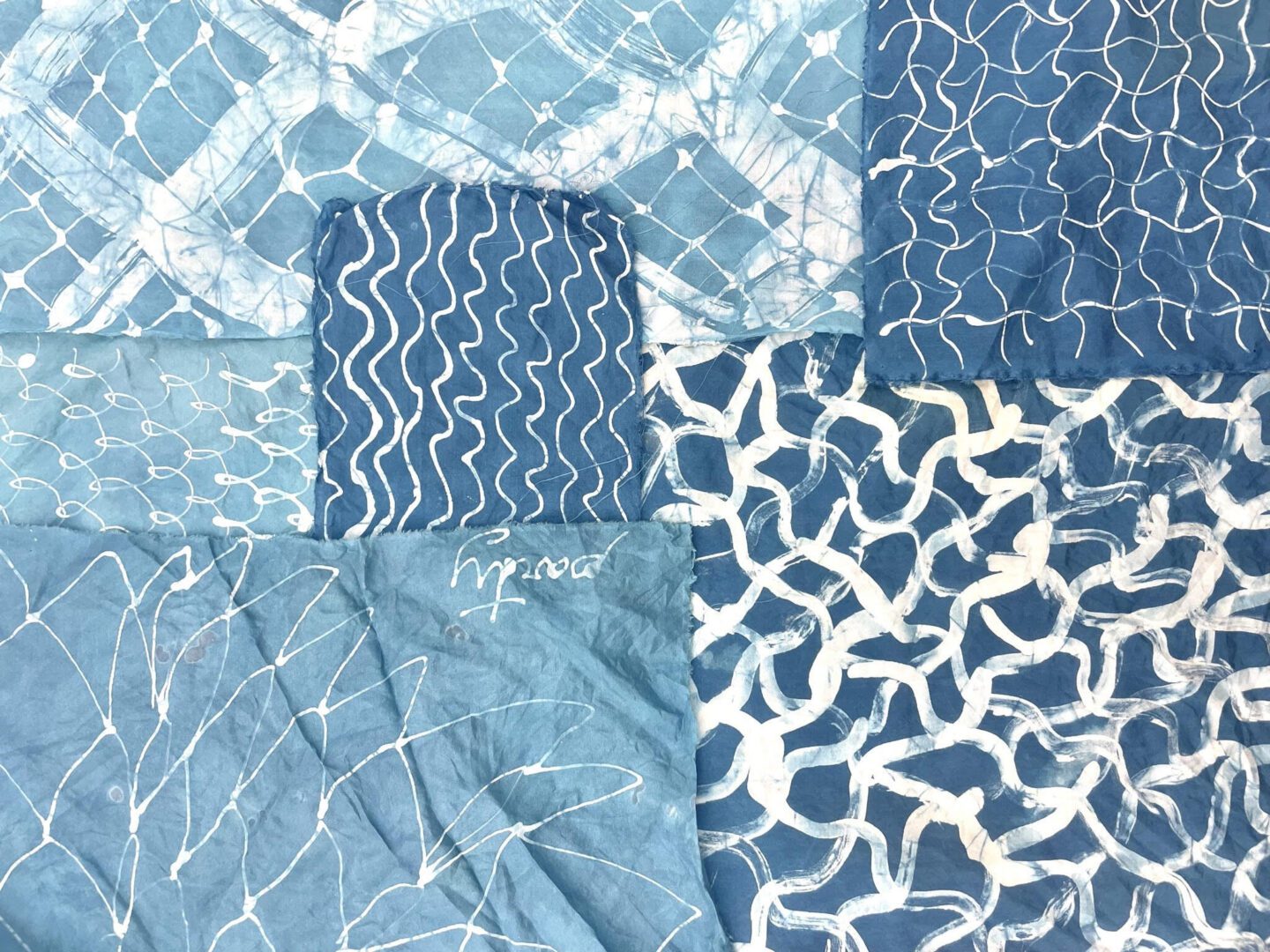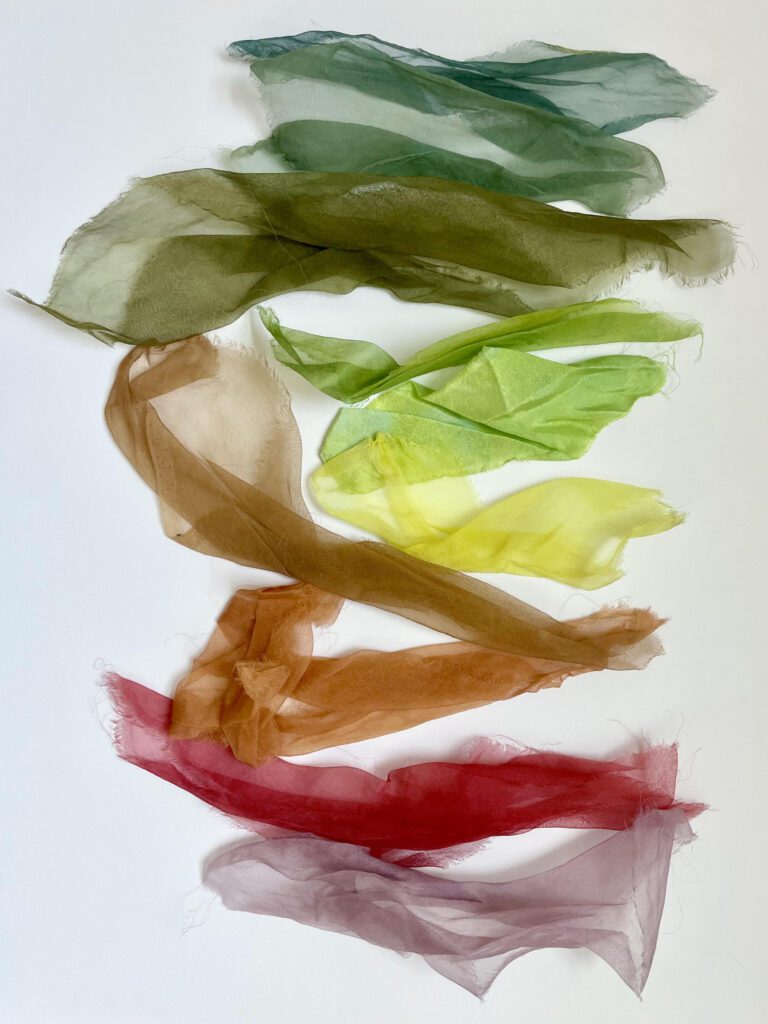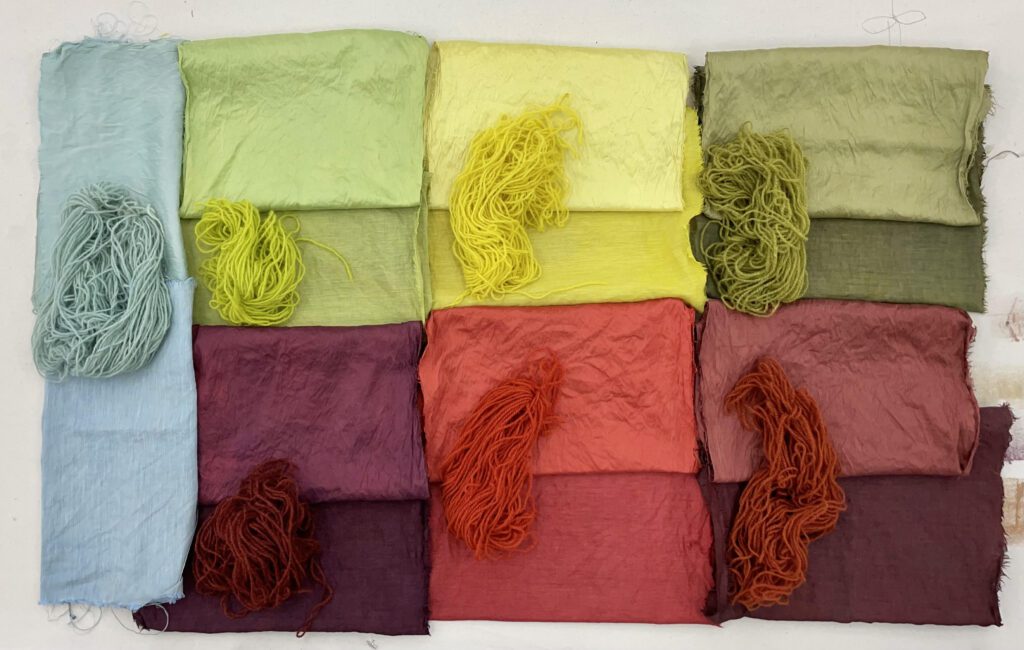
Isa Rodrigues is a textile artist and educator based in Brooklyn, NY and Lagos, Portugal. Her work explores how textiles are intimately connected to the body, the land, and memory. Isa gathers inspiration for her evocative batiks and weavings from the ever evolving environments around her, be it Portugal or Brooklyn. In addition to her personal artistic practice, she is a professor in the Fashion Design department at the Pratt Institute, a founding member of the Textile Arts Center in Brooklyn, and has stewarded many natural dye gardens around New York. Between October 25th-27th, Isa will host a series of classes dedicated to natural dying. We recently spoke with Isa about her artistic process and ever-morphing relationship to color, place, and teaching. We invite you to read our conversation and register to learn with us below.

We’d love to start with a discussion of your practice.
I’ve recently been describing it as a patchwork because I do love the textile term, but also because I think that it encompasses the many facets of what I do. I think a big part of that patchwork is my practice as an artist and a maker, and another big part is being an educator. Sharing and facilitating my experience and the knowledge that I’ve accumulated through doing, through making, and through researching. But definitely “making” is kind of the glue that binds all the things that I do.
I’m currently one of the stewards of the Pratt Natural Dye Garden, as well as a collaborator for an eco-feminist natural dye garden and art residency project in Tangier, Morocco, led by artist Yto Barrada. I’ve been involved with many natural dye gardens in the past. So I guess this practice as a grower of materials is also part of the patchwork. The practices of making, educating, and growing materials are all connected by an emphasis on the hands-on, on materiality, and how the materials can embody meaning and histories.
What draws you to teaching? Do you think there is something about textile art that lends itself to teaching?
This is something I’ve had to think about recently because someone else asked me that question. It’s something that happened very organically. I never thought about becoming an educator. Throughout my life, since I was a child, I’ve kept an art making practice, very much inspired by my grandmother’s. That was always very important to me. Then I went to school for art conservation and specialized in textiles. There something clicked, in terms of this idea of preserving material culture and preserving objects. The part that really clicked was that we can preserve the objects, but if the practice of making is also not preserved then we’ll have rooms full of objects that no one understands. The stories, the processes, the embedded value and memories archived in each object will not be able to be accessed by most people, only by the exclusive group that studies them. I think that was really my entry point for teaching. Sharing what I knew and learning from others and facilitating spaces where this exchange of information could happen. That inspired me to become an educator, and to contribute in this way to the preservation of our shared history and shared knowledge of material culture.
That’s such a beautiful thing to say. We can have an object, but if people can’t make it, if they don’t know how to construct it, we lose such an essential part of that object.
The people, the materials, the land, that is all archived in the object, right? It’s even beyond the people that made it. The choice of materials and techniques are all consequences of a particular context. Social, geographical, political, all of that. I don’t think everyone needs to become a maker or a practitioner, but I think having access to those processes, or to that knowledge and way of thinking, allows you a different entry point that leads to more respect for these objects and their heritage.
Absolutely. Do you feel like the art that you make depends on where you are geographically, or do you feel like your practice is relatively consistent?
I would say yes and no. I think the art I make is deeply influenced by this idea of place. It’s often not the place that I am physically, but it’s the place that I am constantly in my mind. My current work is deeply influenced by my home and connections with the place where I grew up [Lagos, Portugal]. Oftentimes it’s based on real experiences, oftentimes it’s romanticized, nostalgic. But I’m interested in this idea of place and belonging, and the idea of situated knowledge, and how a place shapes you and your practice. Sometimes my art is also influenced by other places, but I often go back home. You can see in the color palettes and some of the expressions in my work that I try to go back to these coastal places. But perhaps this is my era for that, and maybe one day I’ll move to the mountains and there will be some radical shift in my work.

Can you tell us a little about what the process for creating one piece of work is? Do you have an idea that you work with, or is it just moving through you as you go?
I used to joke and say that I would dream about something and then I would have to make it happen. And it’s not so much a joke as it’s pretty accurate. A dream could be like a daydream. I can have so many ideas, sketchbooks and sketchbooks full. Not all of those ideas manifest. I think the process of going from an idea or inspiration to its realization depends on the endurance of that idea. Some ideas are recurrent, they keep coming up. Sometimes it’s just an image. Sometimes it’s just a feeling or something that deeply moved me that I’m trying to capture and understand. If an idea is persistent enough, that leads me to try to investigate it and try to resolve it in one way or another for myself. Those ideas are the ones that manifest as a tangible work. And other times I just make things because I want to scratch an itch or just make something beautiful. I just finished a rag rug because I needed a rug for my kitchen, and I wanted to learn that technique, and I did it. So I think it’s not always super conceptualized.

How did you come to natural dyeing?
I studied natural dyes while I was studying textile conservation in school. I arrived at it from a materials science and studies approach in which I was investigating the type of natural materials that have been used to provide color for historical textiles, kind of doing a little bit of the archeological work on that end. At the same time that I was working with complex analytical systems to discover exactly what molecules were responsible for color, we were also working with natural materials. That was my introduction to natural dyes. I thought immediately that it was something that was quite magical. I would be lying if I said that I had thought about the origins of color prior to school. I think I became intrigued with this convergence of chemistry and alchemy and art practice and science. The more I learned, the more intrigued I became. I think natural dyeing encompasses a lot of the things that I think about in terms of textiles. Color can be so specific to a place. If we’re working with natural dyes, a color can be seasonal, a color needs to be grown and tended, that needs resources, that implicates labor, and that’s just the beginning. As I left college and also left the field of conservation, I shifted my focus and interest more to my creative practice, but also to an interest in growing the materials too.
I come back to natural dyes as a preferred medium for exploring color because of its complexity. I’ve been using the term bouquet, as in each natural material that doesn’t produce just a single dye will produce a complex bouquet of colorants that are deeply dependent, again, on growing conditions, geographical context, climate, but also on the grower, and how they were tended to. So there is this relationship of collaboration between humans and nature. I’m interested in those nuances. I’m interested in not necessarily trying to replicate colors or get very specific colors, but trying to just roll with it.

The “bouquet” of different colors and palettes is lovely. Do you have a dye that you love to work with the most? Do you have a favorite one?
I do… not a dye necessarily, but I’ve been really interested in rediscovering the landscape and the environment around me, looking deeper and beyond “the traditional” natural dyes. Like the dye materials that became objectified through lenses of colonialism and imperialism because of their economical value. I’ve been interested in exploring dyes that did not necessarily enter that conversation but are so specific to the places where I live. So for instance, when I’m home, what colors are growing at certain times? Or right now in New York, everywhere is covered with goldenrod which is one of the best natural yellows, and yet it grows in every abandoned lot and industrial area. So I’m interested in how we can have a more expansive and generous relationship with our surroundings and not just hyperfocus on some materials.
But of course because of the ocean as my main muse and inspiration, I tend to work with a lot of blues. Since this summer, I’ve been thinking a lot about seaweed and kind of shifting from blues to teals and greens. I can’t seem to escape working with indigo, I keep going back. There is something about indigo that is so fascinating, I could think about it 24/7. The ways that it is the only permanent blue from the organic natural world, and how nature was generous to provide different species of plants that produce for different parts of the world. Some of these plants are not even related botanically, but they all produce indigo.
Well, we love blue here! What do you hope that students at your TATTER workshops will gain from the experience of learning from you and working with these dyes?
I hope all my students gain an appreciation for the process, an appreciation for the resources needed to produce those materials. And I hope that they gain an expanded curiosity and continue experimenting. I think each class is just the beginning of a creative journey. Regardless if you’re a beginner or more experienced maker, you’re still in the beginning of that journey. I think that part of being a maker and a creative is that the journey doesn’t culminate with a final answer, an answer just creates more questions. I hope that my students become even more energized to engage in that journey and continue practicing.
Sign up for Beyond Blue: Overdyeing Natural Dyes with Indigo
Sign up for Resists, Mark-making, and Indigo
